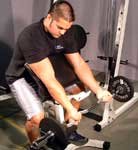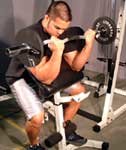
TOPIC: Are Free Weights Or Machines Better For Results?

The Question: This is an old question, but one that keeps coming up with new trainers. Should you only use free weights in your quest for muscle growth? Or should you use machines to get the same or better results, but with more safety? Are "old school" dumbbells better than the latest machine technology? Can machines help you target specific muscles better?
Should you use a combination of free weights and machines? If so, what type of combination? Are there times when one type is better, and other times when the other would be more productive?
Bonus Question:
What is your favorite free weight exercise? What is your favorite machine exercise? Why?
The Winners:
- ATrainer View Profile
- Audioslave View Profile
- ravadongon View Profile
Prizes:
- The best response will get $50 in credit to use in our online store!

1st Place - ATrainer


 Free Weights Or Machines?
Free Weights Or Machines?

One of the questions commonly asked about resistance training is whether to use free weights or machines. The dilemma that you face is relatively complex. On the one hand, free weights give you a more comprehensive training effect in that many stabilizer muscles are involved. Machines have the benefit of working your target muscle through an alleged optimal range of motion.
One other possible benefit is that many machines come with cams that vary the resistance through your muscle's natural strength curve. This cam, used properly, will cause a progressive loading of resistance on the target muscle. Constrained by the necessity of loading bars and cables with undeviating weight, we can't utilize the progressive loading principle with free weight movements.
Regressive Loading
Even worse, I have realized that many, even most free weight movements succumb to what I have termed Regressive loading. Free weights use genetically imposed leverages that we cannot change, this being determined by the length of our bones and the various lengths of our muscle bellies.
Our musculoskeletal system is a complex system of levers. A lever system is bound by the laws of nature. The laws of leverage can pose a threat to the principles of muscular overload.
The laws of leverage consist of simple arithmetic. A lever contains three components; a fulcrum or balance point, a resistance, and a force that either pushes or pulls the lever. The distances and placements of these three components in relation to each other determine the degree of leverage advantage or disadvantage.
Resistance always pulls in the direction of gravity, or with cables, in the direction of the pulley (displaced gravity). To place our muscles in a state of overload, it is in our best interest to utilize movements that place our muscles at the greatest leverage disadvantage possible without risking injury.
Regressive Loading Example
One of the best examples of regressive loading I know is preacher curls. With gravity as point zero, the preacher curl starts out at around 35-40 degrees. Regression starts at around 135 degrees. The preacher curl moves to around 180 and sometimes 200 degrees where you totally lose the resistance to the bicep. That gives you 100-110 degrees of useful range, and about 40-50 degrees of wasted range and unwanted rest from the resistance.
The best thing to do is use the vertical face of a preacher bench. Your humerus must remain absolutely vertical through the entire movement. Proper range would start @5-10 degrees, and end no higher than 140 degrees.
This gives you around 130 degrees of useful range where you move toward a leverage disadvantage, without rest. Efficiency achieved... and yes, it is extremely difficult; It's supposed to be or it wouldn't work.
Avoiding Regressive Loading
By avoiding regressive loading, we can make isotonic movements that work much better. In order to avoid regressive loading, you must rethink the orientation of each exercise in relation to the pull of gravity. It is possible to rework many free weight movements and effectively eliminate the regression of the resistance.
Those free weight movements that can attain this I prefer to keep in my routine. However, many are inherently doomed to the regression or even total loss of the resistance to the working muscles. I don't waste my time on them.
My training has evolved with a tendency toward machines as I have sought to eliminate regressive loading. Machines serve to support my body as I do various movements. One of my techniques is enhanced by support of the movement's fulcrum.
This sacrifices some of the benefit of working stabilizing muscles, but the tradeoff in efficiency to the target muscle is well worth it.
Many brands of machines don't let me accomplish the technical precision I demand from my exercises, so I can't say that machines in general are good. There are many pieces of equipment that I refer to as paperweights. A machine that can allow me to incorporate my techniques is very effective at working the targeted muscle.
When I use such a machine, it lets me work a muscle so completely that I can accomplish muscular overload; and then I go on to another target muscle. That is how I can overwhelm my muscles with one or two exercises.
Cables
I have found that cables are extremely effective at creating ranges of motion that progressively load the resistance, and even better, place my muscle in the worst leverage disadvantage possible. An added benefit is the use of the stabilizing muscles that free weights incorporate.
Since I can pull a cable from any direction I need, I can adjust my body position to be supported against the resistance, and still allow a completely resisted range of motion for the movement.
Theoretically, I could develop a whole routine that would rely exclusively on cables. They are that effective. Cables allow for the complete elimination of any regressive loading. The addition of various pieces of supportive benches has the potential of creating perfect movements.

 Conclusion
Conclusion

So when the old debate about which is better, machines or free weights, comes up, you better have an understanding of the regressive loading principle to back up your argument; or you will probably be wrong.

 Bonus Question
Bonus Question

- Favorite Free-weight: Trap shrugs because they actually work.
- Favorite Machine: Lat shrugs on a lat machine because my biceps don't get in the way.

2nd Place - Audioslave

Free weights versus machines is a common argument and a very important one. Both are effective, but serve different purposes. I'm going to examine free weights and machines - the differences, and the similarities. I will then discuss which is more useful for bodybuilding.

 Free Weights
Free Weights

Free weights is how weight lifting began. It's made up of dumbbells and barbells. It is the most simple idea and possibly the best idea.
What Are The Pros Of Free Weights?
Well, when using free weights you are stabilizing the weight, which will force you to use other little muscles that you didn't know you were using. The person is the only thing supporting the weight. It's only the human and the weight. There is no string, attachments or anything to help.
This is a great feature because more of your muscles are being worked. YOU are the only one moving and controlling the weight, which makes it harder and MORE EFFECTIVE. Another great feature of free weights is it can duplicate sport activities.
An example of this is how I shadow box. When I shadow box I use two dumbbells (free weights) and punch in front of a mirror. This help increase my speed and strength in my arms and shoulders. This advantage is very important for athletes who want to increase their performance.
What Are The Cons Of Free Weights?
Free weights are great to workout with, but they will leave you more prone to getting injured. Like I said before, stabilizing the weight will make you use more muscles throughout your body, but it can also leave you injured. Because of this you MUST use proper form. You must always concentrate on what you are doing. You have to fight the momentum on the negative.
If you move to fast and don't pay close attention to your form you can go past your normal range of motion and end up with a bad injury. Free weights can also be hard on your joints (I learned this the hard way). This is why you MUST focus on form and control the weight.
When using free weights serious injuries can come from dropping the weight on yourself. Their have been deaths of people benching and dropping the weight on them. This is a serious issue. When using free weights a spotter is a great idea to prevent serious injuries.

 Machines
Machines

Machines are a newer way of building ones body. They have become very popular for people who want to workout at home.
What Are The Pros Of Machines?
Using a machine you don't have to worry about a 300lb barbell falling on you. Machine are very safe. Most machines will lock the weight for you and stop it from falling on you. Most of them will also keep you in a standard range of motion, therefore you will have less of a chance of pulling a muscle or creating any other injuries because you won't be going past your limits.
Machines will also help you control and stabilize the weight. They will help you focus more on a single body part. Machines are best used for beginners because it helps them get used to the proper form of the exercise without getting hurt.
What Are The Cons Of Machines?
Machines can be costly and break. A cheap machine may not last very long. A piece can break, a wire can snap etc. A machine puts you in an awkward range of motion. It's not a natural range of motion and therefore you won't be using all of your muscles to stabilize the weight.
Many machines are also easily outgrown. As you progress a machine just won't do the trick for you anymore.
So, What's Better?
In my opinion free weights are better. They are cheap, you cannot outgrow them, and they have more variety of exercises. Machines are good to add into a workout routine, but free weights are the basis of a strength training regimen. I really don't think you can get a really good body in a decent time without free weights. Free weights deliver better and quicker results.
Free weights are old school, and they worked well. So, if it ain't broken, don't fix it! Overall free weights are going to help you achieve better and faster results.

 Bonus Questions
Bonus Questions

What is your favorite free weight exercise? What is your favorite machine exercise? Why?
- My favorite free weight exercise is squats. They hit the legs the best and hardest. Squats are also the ultimate exercise for gaining mass. It's a great exercise that can be used for strength and some endurance. No machine could ever duplicate this free weight exercise.
- My favorite machine exercise would be tricep press-down. I feel that I don't get a good enough triceps workout with just free weights. Plus it adds to the variety of the few good triceps exercises there are.

3rd Place - ravadongon

Free Weights or Machines, which is superior? The answer may seem obvious to some, but it must be stressed that both have their places and uses in fitness...
To delve further into the topic, lets look at the plus/minus side of the equation with both free weights and machines (all the different types)

 Free Weights
Free Weights

Dumbells/Barbells
- Free from machine support or pulley assistance.
Plus (+)
 Can fit any size exerciser
Can fit any size exerciser
 Large exercise potential (alot you can do)
Large exercise potential (alot you can do)
 Can work in three planes of motion for greater muscle recruitment
Can work in three planes of motion for greater muscle recruitment
 Can adjust weights in small increments
Can adjust weights in small increments
Minus (-)
 Greater risk of injury
Greater risk of injury
 High supervision required (including spotters for heavy lifting)
High supervision required (including spotters for heavy lifting)
 Very easy to fall into poor form
Very easy to fall into poor form
 The hardcore image can intimidate some exercisers
The hardcore image can intimidate some exercisers
Bottom Line
Suitable for all individuals, but may not be best suited to beginning, de-conditioned, or elderly exercisers who have never weight trained before.

 Machines
Machines

Selectorized
- A weight stack held together by a pulley and cable system. It allows the exerciser to select weight manually, often with a pin that is inserted into the weight stack at the desired weight.
Plus (+)
 Very easy to learn and use
Very easy to learn and use
 Minimal supervision required (very safe)
Minimal supervision required (very safe)
 Defined movement for safety and proper form
Defined movement for safety and proper form
 Variable resistance adapts to natural strength curve
Variable resistance adapts to natural strength curve
Minus (-)
 Can be difficult to maintain proper form on some machines that allow
Can be difficult to maintain proper form on some machines that allow
use of two planes of motion
 Fits the "average" size user
Fits the "average" size user
Bottom Line
Suitable for beginning exercisers or those new to strength training.
Plate-Loaded
- Plate-loaded machines are those that require weights to be manually loaded and unloaded, e.g. leg-press machine, smith machine.
Plus (+)
 Brings safety to a free-weight experience - no spotter is required
Brings safety to a free-weight experience - no spotter is required
 Replicates "feel" of free weights
Replicates "feel" of free weights
 Many feature independent arm movement, allowing each limb to be
Many feature independent arm movement, allowing each limb to be
exercised alone
 Allows for heavier training
Allows for heavier training


Iron vs. Rubber Plated Plates. If you are one of the few
and rightfully proud Olympic lifters out there,
you need rubber coated 'bumper' plates for your training.
Minus (-)
 Requires user to transport and load weights - may increase risk of injury
Requires user to transport and load weights - may increase risk of injury
 Fits "average" size user
Fits "average" size user
 Again like with free weights, the hardcore image may intimidate some
Again like with free weights, the hardcore image may intimidate some
exercisers (although not as many as free weights will)
Bottom Line
Suitable for all levels, but may not be best suited to beginners, de-conditioned, or elderly exercisers who have never weight trained. Fine for athletes and heavy weightlifters.
Electronic & Pneumatic
Electronic:
- Electronically controlled weight assistance with digital controls.
Pneumatic: Machines that are dependant on air pressure to provide resistance on both eccentric (positive) and concentric (negative) movements.
Plus (+)
 Less intimidating - no weights to carry or set up
Less intimidating - no weights to carry or set up
 Small weight increments for easier progression
Small weight increments for easier progression
 Eccentric load training is an option on some machines
Eccentric load training is an option on some machines
 Simple to adjust weights
Simple to adjust weights
Minus (-)
 Cost, space, and special electrical or pneumatic requirements
Cost, space, and special electrical or pneumatic requirements
 Unnatural feel compared to lifting actual weight stacks, barbells, or
Unnatural feel compared to lifting actual weight stacks, barbells, or
dumbbells
 Fits the "average" size user
Fits the "average" size user
Bottom Line
Suitable for those who may prefer privacy to strength train, such as the elderly, the de-conditioned, and those new or returning to exercise or experienced lifters who want to conduct heavy negative training.

 Conclusion
Conclusion

Free-weights, Machines, and Cables should be looked upon as tools in a toolbox. Each has a different purpose, and each is useful in different situations.

 Bonus Question
Bonus Question

- Favorite Free Weight Exercise
The Clean (partial olympic lift). The reason I like this exercise is because of the intensity and usefulness of the exercise. It's a total body exercise and does wonders for your explosive power and speed.
- Favorite Machine Exercise
This is a tough one, seeing as I don't do many machine exercises these days. But the one exercise I have kept in my program through all the changes I have made is the Standing Calf Raise on the Hack Squat Machine. I like this exercise mostly for its convenience. It's safe and still gives my calves a good work over.




